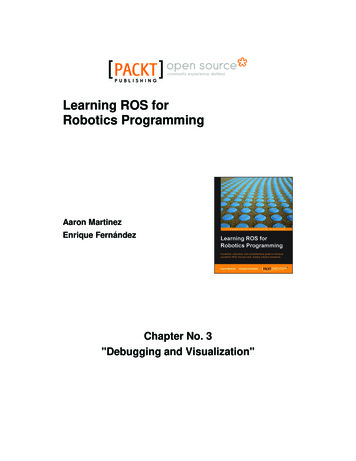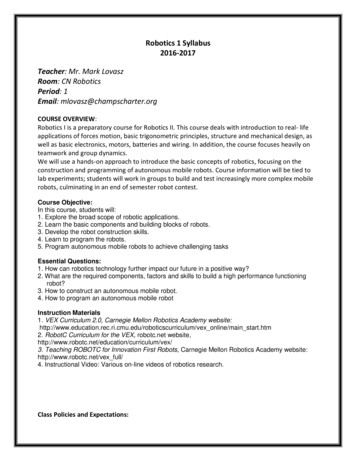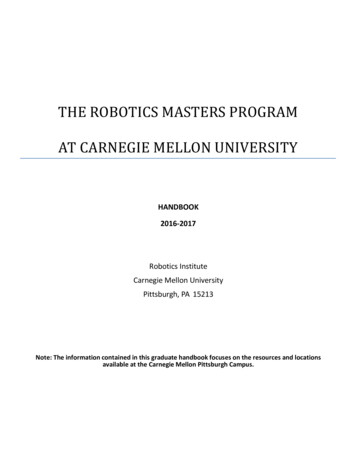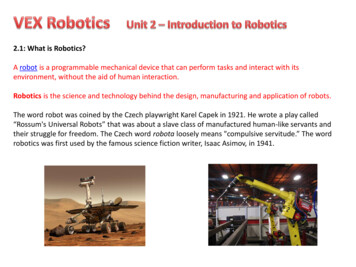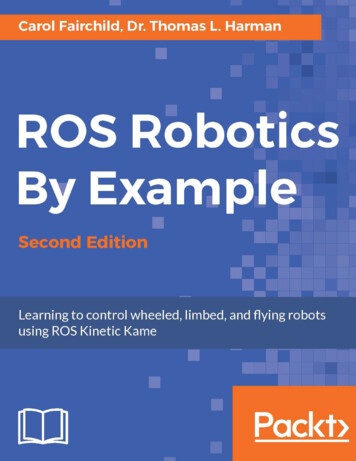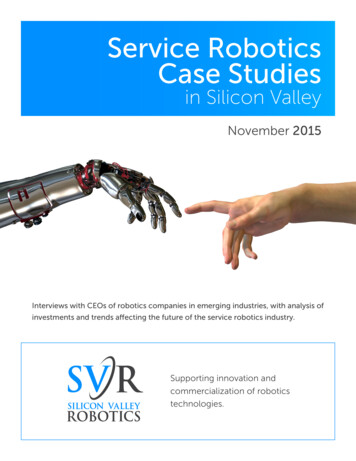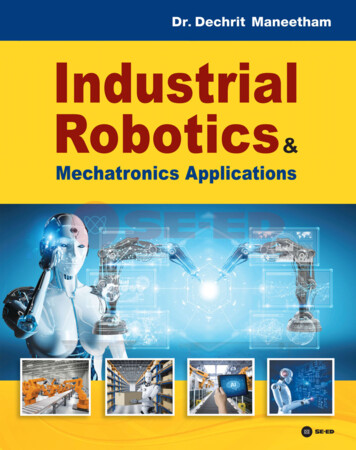
Transcription
IndustrialRoboticsMechatronics Applications'U 'HFKULW 0DQHHWKDP n ³ ² « ¶Æ n ³ H ERRN ¿ «µ n³ ¶Æ m³« Á  n¾ Å ² Á OO PC ¿ Notebook ¶Æ www.se-ed.com« ² SmartPhone ¿ Tablet ¹ ¶ Æ n ¶Æ http://m.se-ed.com ( m³ browser ¾ n³ µ ¾ q¾ Å ¿ n Bookmark Home Á n ³  n¾ App ¹ ³ ) µ ² Ç SE-ED Application  n ³ Play Store Android ³ App Store iOS
x Ä É o µ ºÊ Á } ε ª µ Á¡ºÉ Ä oÄ µ µ f µ n Á · µ µ º Á } ª ¡·Á« Á } o » µ · n µ µ µ¡·Á« Å o É iµ µ · Á È ¼Á É Îµ ( µ ) Á É 1858/87-90 Á ¡  ª µ µÄ o Á µ µ » Á ¡² 10260 à « ¡ r 0-2826-8222 à µ 0-2826-8359x µ ε ³ ε º · µ µ · n Å o É comment@se-ed.comIndustrial Robotics & Mechatronics Applicationsà « Á § ·Í µ µ 420 µ ª · · ·Í µ µ à « Á § ·Í oµ Á  ε Êε ¡· ¡r º ³ ε ºÉ Ä Ã ª· µ Ä Ç Ä ¼ Â Ä Ç Å nªnµ nª ¹É nª Ä º Á n Ê Á¡ºÉ Á ¡ nÄ ºÉ » ³Á º Á¡ºÉ ª » ³ rÄ Ç µ ³Å o » µ 0 4 6 - 1 8 8 - 4 0 80 1 6 6 9 8 7 6 5 4 3 2 1 o ¼ µ µ » ε »  n µ ·Á § ·Í Industrial Robotics & Mechatronics Applications. -- » Á ¡² : Á È ¼Á É 2561 492 oµ 1 »n r I ºÉ Á ºÉ 629 892ISBN 978-616-08-3297-2 ¡· ¡r ³ ε nµ à Á É 1858 87 90 Á ¡  ª µ µÄ o Á µ µ » Á ¡² 10260à « ¡ r 0 2826 8000¡· ¡r É · ª ¡ · Ê r 1991 ε Á É 23 71-72 ¼n 1 Á ³Á 10 µ » Á µ ³Á  ª  ε Á µ » Á » Á ¡² 10150 à « ¡ r 0 2451 3010 µ ª· µ ¡ µ ¼o¡· ¡r ¼oà µ ¡.«. 2561
PrefaceIndustrial Robotics & Mechatronics ApplicationsLLL This book is an attempt to provide a basic background to industrial robotics and mechatronicsapplications and provide links through to more specialized skills. Robotics is an interdisciplinary fieldthat ranges in scope of theoretical concepts and important techniques. The definition of a robot, whichcan be summarized as: vURERW FDQ EH QDPHG DQG GHILQHG DV D SURJUDPPDEOH VHOI FRQWUROOHG GHYLFH FRQVLVWLQJ RI PHFKDQLFDO HOHFWULFDO HOHFWURQLF DQG FRPSXWHU EDVHG V\VWHPV LQ RUGHU WR FRQWURO SURGXFWLRQ SURFHVVHV ZLWK WKHP QRZ EHLQJ XVHG LQ D YDULHW\ RI PDQXIDFWXULQJ DQG DXWRPDWLRQ DSSOLFDWLRQV w The study of robotics concerns with the desire to synthesize aspect of human function by theuse of mechanisms, sensors, actuators and computers. Obviously, this is huge undertaking, whichseems certain to require a multitude of ideas from various classical fields. The book is organized asfollows:Chapter 1 is an introduction of robotics, type of robots and the manipulator of robots.Chapter 2 covers the mathematics used to describe position and orientations such asmechanism analysis, forward kinematics, invers kinematics and the Jacobian and velocity kinematics.Chapter 3 covers the field of machine vision, machine vision software with NI Vision Builderand NI LabVIEW,Chapter 4 we study an industrial robotics and PLC control, Beckhoff PLC, the tasks focus onthe requirements of digital-to-analog converters (DACs) and analog-to-digital converters (ADCs),Chapter 5 we deal for a microcontroller and intelligent robot, microprocessor and microcontroller, microcontroller arduino, control statement in C language, input and output functions, StepperMotor and DC motor control.
LY Industrial Robotics & Mechatronics ApplicationsPreface Chapter 6 the topics related to the mechatronics applications. For example, hydraulic servosystem, Simulink model for closed loop control, PID, Fuzzy and Hybrid Control, H Infinity Control.I hope that the knowledge acquired from this book would enable the practicing engineers andthis book is of use to those engineers developing robotic systems successfully.'U 'HFKULW 0DQHHWKDP e-mail: dechrit m@rmutt.ac.thor dechrit m@hotmail.com
ContentsPageiiiPrefaceUnit 1Unit 2Unit 3Unit 4vIndustrial Robotics & Mechatronics ApplicationsAn Introduction to Robotics11.1 An Introduction to Robotics31.2 Types of Robots141.3 The Manipulator of Robots24Summary47Questions48Kinematics of Robot Manipulators2.1 Analysis of Mechanisms49512.2 Forward Kinematics612.3 Inverse Kinematics of Robotics932.4 The Jacobian and the Velocity Kinematics108Summary118Questions119Machine Vision System3.1 Machine Vision1211243.2 Machine Vision Software132Summary163Questions164PLC Based Control of a Robot Manipulators4.1 Beckhoff PLC1651674.2 PLC Input and Output Devices179
viUnit 5Unit 6Industrial Robotics & Mechatronics ApplicationsContents4.3 PLC Control for the Input and the Output r and Intelligent Robot5.1 Microprocessor and Microcontroller2332355.2 Control Statement in C Language2475.3 Arduino: Input and Output Functions2535.4 Stepper Motor2995.5 DC Motor3185.6 Sensors330Summary352Questions353Mechatronics Applications6.1 Hydraulic Servo System3553606.2 Hydraulic Servo System Applications364Summary418Questions420Appendix A233421Appendix B431Appendix C459AppendixBibliography477Index481
Unit 1An Introduction to Robotics11.11.21.3An IntroductionAn Introductionto Roboticsto RoboticsTypes of RobotsThe Manipulator of RobotsSUMMARYQUESTIONSAn Introduction to RoboticsTypes of RobotsThe Manipulator of RobotsSummaryQuestions1
2Industrial Robotics & Mechatronics ApplicationsUnit 1
Unit 1An Introduction to Robotics3Industrial 4.0 is the way of the future for industrial players. It will determine how they will decideoperate, while at the same time, accelerating the convergence of the virtual and real worlds. Inaddition, Industrial 4.0 has become the new model for the global manufacturing industry. In thefactories of the future, more and more intelligent robots will carry out particularly sophisticated missions,way beyond simple assembly tasks. In order to meet the new requirements and the market needs,industrial players will have to be able to diversify their products. The more varied their product line, themore competitive it will be. Robots will have the ability to communicate with each other. They will beable to adapt their production activities to the customer’s demand, while demonstrating the greatestamount of flexibility.In recent years, factories have increasingly digitized their work tools. The result has been thatthe entire industrial process, from manufacturing to warehousing, distribution to sales, is becomingincreasingly networked and communicated in real time. One has to only consider an automatedproduction line. Industrial 4.0 is becoming the new model for industrial manufacturing around the world.What is more, industrial robotics will have a key role to play in this “smart factory” model. Robots, whichare central to the factory of the future, are getting smarter and smarter. They can now perform moresophisticated tasks that go way beyond a simple manufacturing assembly.1.1 An Introduction to RoboticsRobots can have either hydraulic, electric, or pneumatic power sources. Their movementconfigurations can range from simple arm extensions and retraction movements, to very complexmovements that involve the body, the upper arm, the lower arm, as well as dexterous wrist movements.These various configurations are differentiated by the number of degrees of freedom or axes of motionthat they can attain. The number of different axes determines the overall dexterity of the robot. Robotsmay have up to seven axes of motion, which include four arm motions and three wrist motions. Theseaxes, or joints, can either be linear or rotary in motion. Another defining aspect is the robot’s workenvelope, which is its maximum reach in all directions. The definition of a robot, which can besummarized as:
4Industrial Robotics & Mechatronics ApplicationsUnit 1 vURERW FDQ EH QDPHG DQG GHILQHG DV D SURJUDPPDEOH VHOI FRQWUROOHG GHYLFH FRQVLVWLQJ RI PHFKDQLFDO HOHFWULFDO HOHFWURQLF DQG FRPSXWHU EDVHG V\VWHPV LQ RUGHU WR FRQWURO SURGXFWLRQ SURFHVVHV ZLWK WKHP QRZ EHLQJ XVHG LQ D YDULHW\ RI PDQXIDFWXULQJ DQG DXWRPDWLRQ DSSOLFDWLRQV w In order to gain a competitive advantage over all of the players in an industry, one must haveupdated systems that are integrated and that have state-of-the-art facilities pre – installed, while at thesame time, having them readily available in the market place. Nowadays, almost every businessprocess is being automated. There are even talks of using Artificial Intelligence already, butunfortunately, this prospect is still in its infancy. We still have a long way to go from finally havingsomething as advanced and as sophisticated as AI.Robots are very well - known for their numerous benefits and the immense value that they canadd to a business. The main reason why robots are used is for the automation of various differentprocedures. The use of industrial robots saves time and money, while increasing the quality and theoutput of work, all at the same time. They provide a consistent and reliable performance. They are idealfor repetitive tasks and they produce accurate results from these said tasks. They are able to handleheavy workloads, as well as having the ability to perform in harsh and unpleasant environments.Additionally, they can easily be reprogrammed, as soon as the need to reflect changes in theproduction requirements and the cycles arise. FIGURE 1.1 A comparison of leading robotic applications in the year 2015. (Source: RIA)
Unit 15An Introduction to Robotics FIGURE 1.2 Estimated annual worldwide supply of industrial robots. (Source: IFR) FIGURE 1.3 Estimated annual worldwide shipments of industrial robots. (Source: IFR)
6Industrial Robotics & Mechatronics ApplicationsUnit 1The strong sales reflect the increased demand for robotics in the work place, such as in theautomotive, plastics, rubber and metal industries. The orders for spot welding robots (33%), togetherwith those which are used primarily in material handling, jumped 39% in the first half of 2015. Other bigjumps were seen in arc welding robots ( 18%), coating dispensing robots ( 4%), assembly robots( 2%), as well as many others ( 4%).Industrial robots are robots that can carry out assembly applications. Traditional industrialrobots have been readily applied in the manufacturing and electronics industries. These automationmachines have a very wide spectrum of robotic applications.The following robots are the different industrial applications of robots that we offer:1.1.1 Robotic Laser CuttingRobotic Laser Cutting is one of the automation solutions that we offer. Our laser cutting robotscan cut both metal and non-metal materials, which are primarily used in making car interior parts, doorpanels, rubber sealing for windows, and more. This technology uses a static laser beam that isintegrated with a moving robotic arm, resulting in one of the most useful devices that has beenimplemented, particularly for automation. FIGURE 1.4 Robotic Laser Cutting
Unit 17An Introduction to RoboticsThis type of industrial robot is made up of a servo-controlled, multi-axis mechanical arm, withthe laser cutting head mounted on its faceplate. This means that it can perform 3D cutting, by reachingin and around, in order to cut the required shape into a particular part – be it simple holes or complexcontours. Another major reason is that the robotic laser cutting system can efficiently perform multipleapplications, such as cutting and welding, by using the same laser cutting head.1.1.2 Robotic Arm Milling MachineThe Robotic Arm Milling Machine is the automated solution to every machining process. It cantake care of welding, cutting, spray painting and even milling. The last mentioned attribute is theprocess of contouring or cutting a specific workpiece from a prototype or a mold, in order to make therequired three dimensional shape. With our Robotic Arm Milling Machine, milling is made more flexibleand easier, despite the complexity of the desired end product.From small parts to larger components, be it a simple shape, or a shape with the most unusualgeometries, our robot can achieve the milling process the same as, or even better than, a factorymachine. It make very accurate cuttings, with precise movements, to create the highest quality of parts.It only takes up a small footprint, when compared to the traditional CNC machining application. TheRobotic Arm Milling Machine can be designed and manufactured in accordance to your specificapplications. FIGURE 1.5 Robotic Arm Milling Machine
8Industrial Robotics & Mechatronics ApplicationsUnit 11.1.3 3D Printing with a Robot ArmRobots are starting to revolutionize the worlds of the manufacturing industries. They haveundoubtedly lived up to their potential – making every aspect of our lives better. There are already selfdriving cars available, humanoids that either help with housekeeping or be a part of a service crew,together with the more widely used industrial robots, which account for almost 90% of robots beingused nowadays. Possibly, the most fascinating procedure available today is 3D Printing, when it usesRobot Arm Technology.3D printing is also known as additive manufacturing. It is a type of free-form fabrication, by‘adding' a layer of raw materials (i.e., resin, plastic, concrete or recyclable materials) over the other,until you have produced the desired object, which is usually based on a digital model. The possibilitiesare limitless with 3D technology. Anything that is available in a digital form can be 3D printed. Fromsmall objects, like a screw, to the larger scale of building houses; anything is now possible. FIGURE 1.6 3D Printing with a Robot Arm
Unit 19An Introduction to Robotics1.1.4 Robotic Spray Painting ArmSpray painting has been performed manually in the past. This actually presents hazards to theworker's health. Despite the safety measures that have been put in place and the employee trainingsthat have been conducted, the fact that human workers are exposed to these harmful chemicals is stillthere. Nowadays, factories have found a way to diminish this health risk by utilizing a Robotic SprayPainting Arm.This robotic application is mostly appropriate in the automobile and fabrication industries,among others. Not only that, the painting process will be much easier and can be completed in only asmall amount of time. The factory will be able to save almost 50% of the painting material. Anotheradvantage of this application is that the robot spray painters are environmentally friendly. They produceless of a carbon footprint, which is good for lessening the negative impacts of the global warmingphenomenon. Moreover, robotic spray painting produces a more accurate and a more efficient result.Most people are initially anxious, when companies have increased their dependency on roboticautomation, when in fact, with robots taking over the dangerous aspects of a job, they are actuallyhelping in so many different ways.Benefit of a Robotic Spray Painterx Taking over the more dangerous aspects of a jobx Resulting in a more accurate painting jobx Environmentally friendly FIGURE 1.7 Robotic Spray Painting Arm
10Industrial Robotics & Mechatronics ApplicationsUnit 11.1.5 Robotic Arm - Pick and Place SystemIndustrial robots are known for speeding up the process, without sacrificing the quality of theoutput or the work. One common robotic application is the Robotic Arm - Pick and Place System. Therepetitive and boring task of picking parts up and placing them in a different location can now behandled by these robots. They do not tired or get bored. They can also conduct these tasks withexactly the same precision, even after hours and hours of work. Moreover, manpower can be utilized ina more efficient and effective way. Other than just performing the same tasks over and over again, thehuman workforce can focus on more important, skill-centered tasks. By integrating robots with thesekinds of task, eliminates the possibility of employee dissatisfaction, which might later on translate intoan increase in staff turnover rates. Aside from that, the pick and place robotic system will givecompanies the opportunity long-term savings.Benefits of a Robotic Arm - Pick and Place Systemx Automates repetitive tasksx Generates an improved productivityx Establishes a higher qualityx Long - term savings for the business FIGURE 1.8 Robotic Arm - Pick and Place System
Unit 111An Introduction to Robotics1.1.6 Robotic Packaging SystemsIn this time and age, almost all products are being picked and packed in the factory. That iswhy shifting to a robotic process of automation has now become a necessity. Not only will it makebatch manufacturing finish in the shortest possible cycle time, It can yield twice as much productivity,as well as a higher quality of output. With at its finest, by the packaging process through the use ofrobots, is much more favorable when compared to the conventional way of packaging despite alreadyhaving dedicated production equipment. What was once a task that took a long while to finish, can nowbe achieved much faster, with more precision, as well as with more flexibility. Robots are now beingdesigned to take over such repetitive tasks in factories of high volume production.Benefits of Robotic Packaging Systemsx Cost-efficientx Taking over repetitive tasksx Yielding high volume, with a higher quality of output FIGURE 1.9 Robotic Packaging Systems
12Industrial Robotics & Mechatronics ApplicationsUnit 11.1.7 Robotic Arc Welding SystemsIn order to stay on top of the food chain, one has to provide the best solutions for the differentchallenges that are inherent in the field. In the manufacturing sector, robots are slowly and surely takingover the industry. Several companies are offering the same products and services in terms of robotintegration and it is now a matter of choosing the correct welding product. We can offer the bestwelding solutions out there with our user-friendly, cheap and durable Robotic Arc Welding Systems.Robotic Arc Welding Systems are one of the many integrations that we provide. Performance,speed and accuracy are the most important features that manufacturing businesses are looking for inan industrial robot. Our arc welding robots can run as much as 24 hours a day, at a faster processingrate, with limited downtime. Another important issue is that manual welding processes usually presentharsh working environments, due to the excessive heat and fumes. Working people are more prone toillnesses and accidents. This innovative way of welding eliminates these risks. The quality is alsoincreased with robotic arc welding machines. With preventative measures in place, as well as withproper employee training, these robots will be able to withstand wear and tear from a continuousproduction cycle. FIGURE 1.10 Robotic Arc Welding SystemsBenefits of Robotic Arc Welding Systemsx Robotic welding allows for the use of an available labor pool for a minimal pricex Higher yields and throughput
Unit 113An Introduction to Roboticsx Less post-welding cleanupsx Lower cost of consumable materialsx Reduction in total time to market1.1.8 Vision-Guided RoboticsRobots provide efficient yet less costly solutions for every conceivable industry., Industrialrobots, on their own, are extremely useful in terms of automation. By integrating sight to your robot andthe possibilities are endless. The production quality will naturally improve a whole lot more by givingrobots the ability to see. With Vision-Guided Robotics, manufacturers will gain the ability to track theirproducts more accurately, improve their inventory management, as well as maximizing inspections andcontrol. Industrial robotics will not be performing the same motion over and over anymore, when visionis integrated into their system. While this feature can be utilized in several applications, it is mostlyuseful in quality control. With cameras in place, they can track objects placed on a conveyor belt, whiletaking pictures of the finished products. Simultaneously, they can compare these pictures to theprogrammed criteria in the system. Through quality assessment, these robots will be able to eitheraccept or reject the finished objects, based on the algorithms put in place, thus ensuring high qualityproducts. All of this will result in a reduced cycle time and less errors, while production efficiency andreliability is increased. Production is made much more flexible with a vision-guided robotic system. FIGURE 1.11 Vision-Guided Robotics
14Industrial Robotics & Mechatronics ApplicationsUnit 1Benefits of Vision-Guided Roboticsx Rapidly transforming the production processes x More accurately moving products to a variable target position x Reducing the cost and complexity of fixed tooling 1.2 Types of RobotsIndustrial robots are defined as 'multi-functional manipulators’ that are designed to movematerials, parts, tools, or specialized devices, through various programmed motions. As such, robotsprovide consistent reliable performances, with repetitive accuracy. They are able to handle heavyWorkloads, while performing in harsh environments. Additionally, robots can be quickly reprogrammed,in order to reflect the changes in production needs and cycles. All of the above-mentioned benefits canresult in vastly improved productivity and quality. However, this robotic technology has certaindisadvantages, which can include:x The need for skilled programmersx The high cost of robotic systemsx Constant maintenance proceduresx Unique worker safety precautionsAn industrial robot is commonly referred to as a robotic arm that is used in a factoryenvironment for manufacturing applications. Traditional industrial robots can be classified according todifferent criteria, such as their type of movement (degrees of freedom), their application in themanufacturing process, their architecture (serial or parallel) and their brand. Then there is also a newqualifier for industrial robots, in that they can be qualified as collaborative or not. This article will nowpresent these different classifications, with some examples. These kind of robots generally manipulatetheir environment, by controlling their position and their orientation of an end-effector. The stationaryrobotic category includes these features by identifying these movements as robot arm and geometriesdescribing them in a coordinated system, as follows:
Unit 115An Introduction to Roboticsx Cartesian/Gantry Robotsx x x x x Cylindrical RobotsSpherical RobotsSCARA RobotsRobotic Arms - (Articulated Robots )Parallel Robots1.2.1 Cartesian or Rectangular/Gantry RobotsThese Cartesian robots are also called. Cartesian robots have three linear joints that use theCartesian coordinate system (X, Y, and Z). They may also have an attached wrist to allow for arotational movement. The three prismatic joints deliver a linear motion along the three axis. This issimilar to the type of ‘work area’ that an overhead crane features. The Cartesian robot can only reachout in front of itself, however, it can move along each axis to the desired point. Figure.1.12 showsCartesian coordinate system’s arms. a) Cartesian or Rectangular coordinated Armsb) An Overhead CraneFIGURE 1.12 Cartesian or Rectangular/Gantry Robot
16Industrial Robotics & Mechatronics ApplicationsUnit 1Major industrial applications of these devices are:x Cutting, Scribing and Sortingx Product Placementx Quick Storage and Retrievalx Packing Automationx General Machining Operations1.2.2 Cylindrical RobotThis Cylindrical Robot has at least one rotary joint at its base and at least one prismatic joint inorder to connect the links. The rotary joint uses a rotational motion along the joint’s axis, while theprismatic joint moves in a linear motion. Cylindrical robots operate within a cylindrical-shaped workenvelope. A cylindrical coordinate system is a three-dimensional coordinate system that specifies pointpositions by their distance from a chosen reference axis, the direction from the axis relative to a chosenreference direction, as well as the distance from a chosen reference plane, which is perpendicular tothe axis. The latter distance is given as a positive or a negative number, depending upon which side ofthe reference plane faces the point. The motion of the main arm is up and down. The robot can performthese motions by extending a cylinder that is built into its arm. In most cylindrical robots, the up-anddown motion is provided by a pneumatic cylinder and the rotation is generally provided by a motor withgears. Figure 1.13 shows a cylindrical coordinated arm.
Unit 117An Introduction to Robotics a) A Cylindrical Coordinated armb) A Cylindrical Coordinated ManipulatorFIGURE 1.13 Cylindrical RobotMajor industrial applications of these devices are:x Assembly Operationsx Handling of Machine Toolsx Spot Weldingx Handling of Die Casting Machines1.2.3 Spherical or Polar RobotThese robot are also called Spherical or Polar Robots. In this particular configuration, the armis connected to the base by a twisting joint, together with a combination of two rotary joints and onelinear joint. The axes form a polar coordinated system and they create a spherical-shaped workenvelope. These robots are more sophisticated than the Cartesian and the Cylindrical Robots, whiletheir control solutions are less complicated than those of articulated robot arms. This may be the reasonwhy they are sometimes used as a base for robotic kinematic exercises. It should also be noted that thespherical robot type takes up a significant spot in robot history, as some of the first robot arms can becounted in this type of robot. Modern industrial robot arms evolved from spherical robots and they are
18Industrial Robotics & Mechatronics ApplicationsUnit 1sometimes regarded as this type of robot, as their work envelope is often spherical like as well. Figure1.14 shows a spherical coordinated arm. a) A Spherical Coordinated Armb) A Spherical Coordinated ManipulatorFIGURE 1.14 Spherical RobotMajor industrial applications of these devices are:x Assembly Operationsx Pick and Place Operationsx Plantingx Welding1.2.4 Revolute or Articulated RobotThe Revolute or Articulated Robot design features rotary joints and it can range from a simpletwo joint structure to 10 or more joints. The arm is connected to its base with a twisting joint. The links inthe arm are connected by rotary joints. Each joint is called an axis and it provides an additional degreeof freedom or range of motion. Industrial robots commonly have four or six axes. A manipulator, whosefirst three joints are revolving joints, is a revolving manipulator. These robots have the highest of activityskills in a working space. They are the most skillful manipulators. They are the most widely used arm
Unit 119An Introduction to Roboticsconfiguration, because of their flexibility in reaching any part of the working envelope. Thisconfiguration of flexibility allows for such complex applications as spray painting and welding and theyare to be successfully implemented in many working situations. Figure 1.15 shows a revolutecoordinated arm. a) A Revolute Coordinated Armb) A Revolute Coordinated ManipulatorFIGURE 1.15 Revolute RobotMajor industrial applications of these devices are:x Assembly Operationsx Pick and Place Operationsx Palletizing Foodx Spot Weldingx Manufacturing of Steel Bridges, Cutting Steel
20Industrial Robotics & Mechatronics ApplicationsUnit 11.2.5 SCARA RobotA SCARA Robot rotates along two axes in the horizontal plane and it moves linearly up anddown. It is commonly used in assembly applications. This selectively compliant arm for roboticassembly is primarily cylindrical in design. It features two parallel joints that provide compliance in oneselected plane. Although originally designed specifically for assembly work, these robots are nowbeing used for welding, drilling and soldering operations, because of their repeatability nature and theircompactness. They are intended for light to medium loads and their working volume tends to berestricted, as there is a limited vertical movement. Figure 1.16 shows a SCARA coordinated arm. a) A SCARA Coordinated Armb) A SCARA Coordinated ManipulatorFIGURE 1.16 SCARA RobotMajor industrial applications of these devices are:x Assembly Operationsx Pick and Place Operationsx Die Castingx Machine Visionx Material Cutting
Unit 121An Introduction to Robotics1.2.6 Parallel RobotWith four degrees-of-freedom, the Parallel Robot link mechanism translates its tool platforminto a fixed orientation, with respect to the X and Y axes. These geometries are very popular in the highspeed packaging industry for light payload applications. The primitive joints can be arranged inparallel, as well as in series. A generalized parallel manipulator is a closed-loop kinematic chainmechanism whose end-effector is linked to the base by several independent kinematic chains. Figure1.17 illustrates such a parallel linked mechanism. a) A Parallel Coordinated Armb) A Parallel Coordinated ManipulatorFIGURE 1.17 Parallel RobotWe will deal mainly with mechanisms with the following characteristics:1. At least two chains support the end-effector. Each of those chains contains at least onesimple actuator. There is an appropriate sensor to measure the value of the variables thatare associated with the actuation (rotation angle or linear motion).2. The number of actuators is the same as the number of degrees of freedom of the endeffector. 3. The mobility of the manipulator is zero when the actuators are locked.
22Industrial Robotics & Mechatronics ApplicationsUnit 1Major industrial applications of these devices are:x Flight Simulatorsx Automobile Simulatorsx Work processesx Photonics / Optical Fiber Alignmentx High Spe
Preface Industrial Robotics & Mechatronics Applications LLL This book is an attempt to provide a basic background to industrial robotics and mechatronics applications and provide links through to more specialized skills. Robotics is an interdisciplinary field that ranges in scope of theoretical concepts and important techniques.

